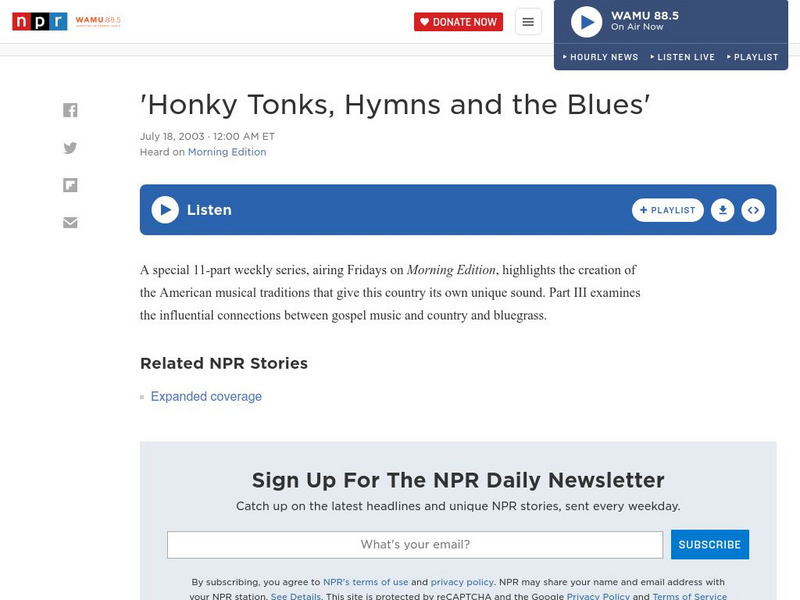PBS
Edward Ball - 'Slaves in the Family' (Nov. 24, 1998)
The 1998 National Book Award winner in the nonfiction category was Edward Ball for his book, "Slaves in the Family". It's about the lives of his slave-owning ancestors on their rice plantations near Charleston, South Carolina. The book...
Curated Video
Mansa Musa and Islam in Africa: Crash Course World History
In which John Green teaches you about Sub-Saharan Africa! So, what exactly was going on there? It turns out, it was a lot of trade, converting to Islam, visits from Ibn Battuta, trade, beautiful women, trade, some impressive...
Crash Course
Mansa Musa and Islam in Africa Crash Course World History
In which John Green teaches you about Sub-Saharan Africa! So, what exactly was going on there? It turns out, it was a lot of trade, converting to Islam, visits from Ibn Battuta, trade, beautiful women, trade, some impressive...
Crash Course
How and Why We Read: Crash Course English Literature
In which John Green kicks off the Crash Course Literature mini series with a reasonable set of questions. Why do we read? What's the point of reading critically. John will argue that reading is about effectively communicating with other...
Curated Video
Mali Emperors Family Tree | Mansa Musa - The Richest Man in World History
Mali Emperors Family Tree | Mansa Musa - The Richest Man in World History
Wonderscape
The Power of Narratives and Literary Devices
This video explores the significance of communication through storytelling, emphasizing the power of the pen in shaping perceptions and actions. It introduces five key literary devices—narrative, plot, tone and mood, setting, and...
PBS
Don’t Know Much About BEOWULF? Nobody Does!
Let’s face it. Between English classes, Lit classes, World Culture classes, and History classes, there’s no escaping The Epic Poem. THE ODYSSEY, THE ILIAD, THE AENEID, THE EPIC OF GILGAMESH, BEOWULF. At some point, we’re going to have to...
Wonderscape
Literature Kids: Rhythm, Meter, and Rhyme
This video is a lesson on poetry, specifically focusing on the topics of rhythm, meter, and rhyme. The teacher discusses the origins of poetry, the use of rhythm and meter to create a distinct sound pattern, and the different types of...
History Hit
Africa: The Unknown History of Humankind
Africa is the second largest continent in the world and is home to the second largest population; but it is second-to-none regarding its ethnic diversity. Throughout history Africa has been the home of many thousands of ethnological...
Curated Video
How Black artists have shaped music across genres
Hip hop historian, journalist and educator Dave Cook and Vancouver musician Henri Brown speak with host Amy Bell about the history of Black music, and how the artistry of Black musicians has touched every genre of music across the world.
Curated Video
Traditional Indian music skills taught in Dubai
LEADIN
A look at a school of traditional Indian performing arts in the heart of Dubai.
STORYLINE:
A little slice of India in the Middle East.
At the Malhaar Center for Performing...
TED-Ed
How Did Polynesian Wayfinders Navigate the Pacific Ocean?
Imagine sailing around the world, or even around the Pacific Ocean, in an outrigger canoe without the the aid of a GPS? Or a compass? Or even a sextant? The Polynesians did. Find out how with an engaging video that details how they used...
NPR: National Public Radio
Npr: Honky Tonks, Hymns and the Blues
Audio story focuses on the unique traditions in American music including country music, blues, and gospel.
Sophia Learning
Sophia: Transmission of the Teaching: Lesson 3
This lesson discusses in general terms the ways in which religious traditions perpetuate and define themselves via sacred texts, oral traditions, ritual, liturgy, preaching, and works. It is 3 of 3 in the series titled "Transmission of...
Sophia Learning
Sophia: Transmission of the Teaching: Lesson 1
This lesson discusses in general terms the ways in which religious traditions perpetuate and define themselves via sacred texts, oral traditions, ritual, liturgy, preaching, and works. It is 1 of 3 in the series titled "Transmission of...
PBS
Pbs: Georgia Stories: The Myths and Legends of the Cherokee People
Explore the Cherokee oral tradition, highlighting stories passed down through the generations. Included are additional activities for teachers to use in the classroom. [6:02]
PBS
Pbs: Indian Pride, Gaming, Part 3
A member of the Standing Rock Sioux Tribe of North Dakota tells a traditional story to a group of young people. [4:16]
PBS
Pbs: Indian Pride, Health, Part 3
Paul "Cowbone" Buster of the Seminole Tribe of Florida tells a story about a little boy who disobeys his mother and sings a song that the little boy sang. [3:38]
PBS
Pbs: Indian Pride, Education, Part 3
Listen to a story about Coyote, who learns an important lesson about individuality. [3:07]
PBS
Pbs: Indian Pride: Culture, Traditions, and Celebrations, Part 3
Walter Pratt of the Pawnee Nation of Oklahoma tells a story about Little Skunk, who disobeys his parents. [2:06]
PBS
Pbs: Indian Pride, Heroes, Part 3
Emmit White of the Salt River Pima-Maricopa in Arizona tells traditional stories, the first about a little boy and Rabbit, and the second about Coyote. [4:26]
PBS
Pbs: Wyoming's Native Americans: Preserving the Ways: Culture & Tradition
Learn what the futures of the Eastern Shoshone and Northern Arapaho tribes are, and how the tribes will retain their culture and tradition while preparing to move into the future. In the accompanying lesson plan (found in the Support...
PBS
Pbs: Indian Pride: Tribal Relations, Part 3
Billy Daniels Jr. of Forest County Potawatomi, Wisconsin, tells his favorite story about the Sun and the Wind. [1:49]
PBS
Pbs: Indian Pride: Advocacy, Part 3
This storyteller's segment tells the story of a man searching for a free meal who tries to trick a group of ducks into being his dinner. [3:50]





